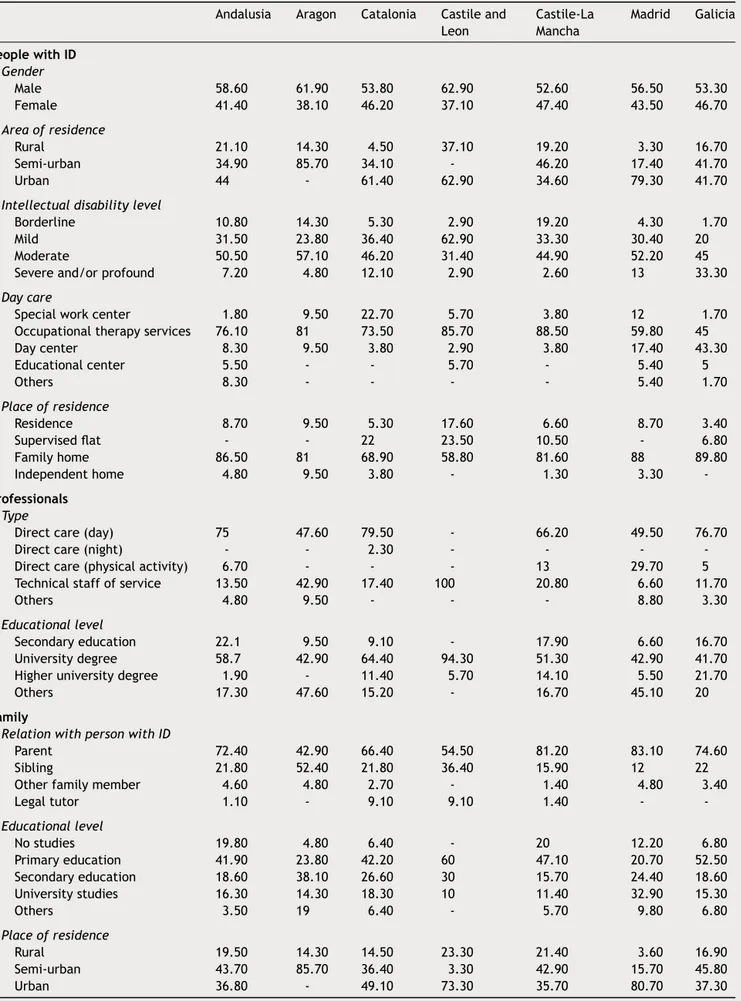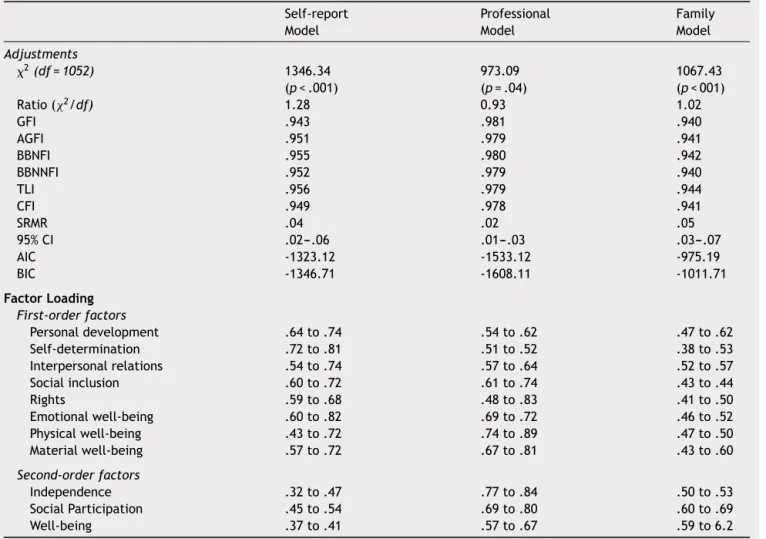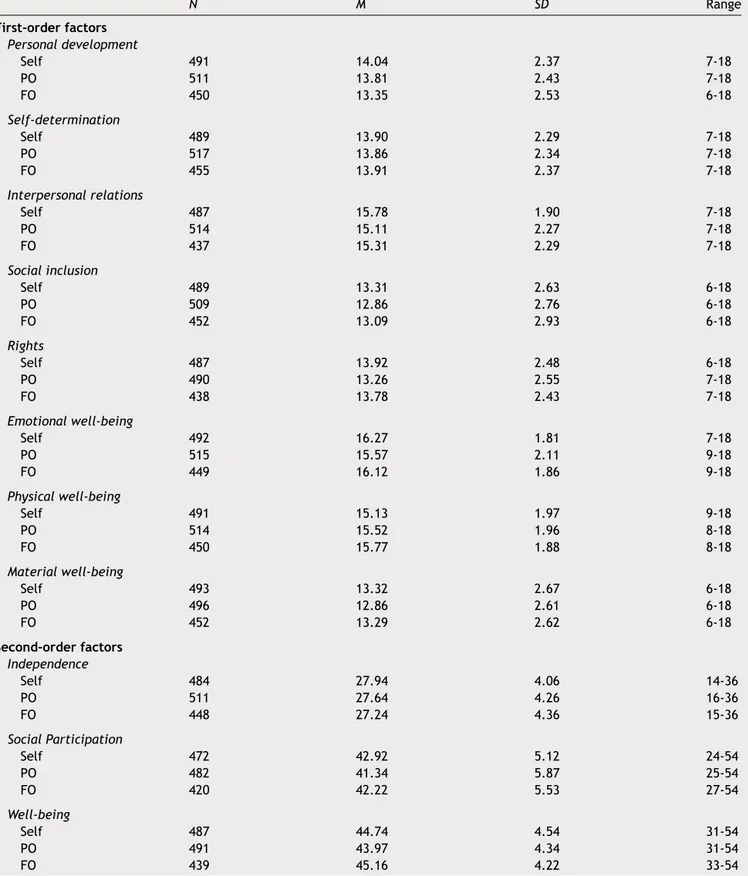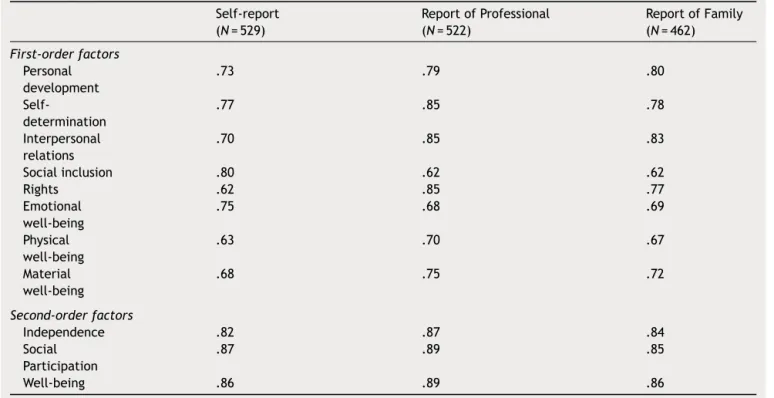www.elsevier.es/ijchp
International
Journal
of
Clinical
and
Health
Psychology
ORIGINAL
ARTICLE
Psychometric
properties
of
the
Spanish
version
of
the
Personal
Outcomes
Scale
Maria
Carbó-Carreté
a,∗,
Joan
Guàrdia-Olmos
b,
Climent
Giné
aaFPCEEBlanquerna.UniversitatRamonLlull,Spain
bInstituteforBrain,CognitionandBehaviour(IR3C),UniversitatdeBarcelona
Received27November2014;accepted20April2015 Availableonline11June2015
KEYWORDS Intellectual disabilities; PersonalOutcomes Scale; Assessment; Confirmatoryfactor analysis; Instrumentalstudy
Abstract Personaloutcomes-relatedqualityoflifeprovidesinformationabouttheimpactof individualizedsupportsandservicesthatareprovidedtopeoplewithintellectualdisability.The PersonalOutcomesScale(POS)isavalidandreliableinstrumentthatmeasurestheseoutcomes usingtwoparts,self-reportandreportbyothers. BasedonthePOS,theaimofthisstudyis toprovideanewpsychometricstudyoftheinstrumentthatallowstheevaluationofthethree principalinformersinvolvedintheenhancementofindividual’squalityoflife:individualwith intellectualdisability,professionalandfamilymember.Thisapproach overcomesthe limita-tionsofthePOS.Fortheself-reportwereinvolved529peoplewithintellectualdisability.A professional(N=522)andafamilymember(N=462)separatelyparticipatedforthereportby othersversionstoassesspersonaloutcomesforeachparticipant.Thereliabilitystudyprovides appropriatevaluesforthefirstandsecondorderfactorswith␣valuesbeinghigherthan.82.The constructvalidityanalysisprovidesanadjustmentofthetheoreticalmodel,particularly regard-ingtheassessmentsfromprofessionals.Resultsshowthisinstrumentisadequatetoevaluate personaloutcomesandgivingtheguidelinesformakingpolicyandpracticedecisions. © 2014Asociación Espa˜nola de Psicología Conductual.Publishedby Elsevier España,S.L.U. Thisisanopenaccess articleundertheCCBY-NC-NDlicense(http://creativecommons.org/ licenses/by-nc-nd/4.0/). PALABRASCLAVE Discapacidad intelectual; EscaladeResultados Personales;
PropiedadespsicométricasdelaVersiónEspa˜noladelaEscaladeResultados Personales
Resumen Los resultados personales relacionados con la calidad de vida aportan informa-ciónsobreelimpactodelosapoyosindividualizadosyserviciosofrecidosalaspersonascon discapacidadintelectual.LaEscala deResultadosPersonales(ERP)esuninstrumentoválido
∗Corresponding author:Facultyof Psychology, Educationand Sport Sciences Blanquerna,UniversitatRamon Llull,Císter, 34,08022 Barcelona(Spain).
E-mailaddress:[email protected](M.Carbó-Carreté). http://dx.doi.org/10.1016/j.ijchp.2015.04.002
1697-2600/©2014AsociaciónEspa˜noladePsicologíaConductual.PublishedbyElsevierEspaña,S.L.U.Thisisanopenaccessarticleunder theCCBY-NC-NDlicense(http://creativecommons.org/licenses/by-nc-nd/4.0/).
evaluación; Análisisfactorial confirmatorio; Estudioinstrumental
yfiablequeevalúaestosresultadosenbaseadospartes,elautoinformeyelinformedelos otros.BasándonosenlaERP,elobjetivoesofrecerunnuevoestudiopsicométricodeeste instru-mentocontemplandolaparticipacióndelostresinformadoresimplicadosenlamejoradela calidad devida:lapersonacondiscapacidadintelectual,elprofesionalyunmiembro dela familia.EstaaproximaciónsuperaloslímitesdelaERP.Paraelautoinformehanparticipado 529personascondiscapacidadintelectual.Elprofesional(N=522)yelmiembrodelafamilia (N=462)hanparticipadoseparadamenteenlasversionescorrespondientes.Elestudiode fia-bilidadaportavalores apropiadosparalosfactoresdeprimerysegundoorden(˛≥.82). El análisisdelavalidezdeconstructoseajustaalmodeloteórico,particularmenteenlos profe-sionales.Segúnlosresultados,esteinstrumentoesadecuadoparaevaluarresultadospersonales yaportarinformaciónválidaparalasprácticasprofesionalesylaspolíticassociales.
© 2014AsociaciónEspa˜noladePsicología Conductual.PublicadoporElsevierEspaña, S.L.U. EsteesunartículoOpen AccessbajolalicenciaCCBY-NC-ND(http://creativecommons.org/ licenses/by-nc-nd/4.0/).
The concept of quality of life (QoL), which is under-stoodtobeasensitizingnotion inthefieldofintellectual disability(ID),hasshiftedtowardsameasurableconstruct thatisexpressedintermsofpersonaloutcomes(Schalock, Gardner,&Bradley,2007;Schalock&Verdugo,2002).These outcomes areunderstood to be‘‘person-defined and val-uedaspirations.Personaloutcomesaregenerallydefinedin referencetoQoLdomainsandindicators’’(Schalocketal., 2007,p. 14).Itisquite logical,then, tobelievethat per-sonaloutcomescanbeusedasareferencefortheservices andsupportthatareprovidedtopeoplewithID(Luckasson &Schalock,2013a;Schalock&Verdugo,2012a,2012b;van Loonetal.,2013).Personaloutcomesmakesensewithina QoL model.Regarding peoplewithID the mostcommonly used is the model by Schalock and Verdugo (2002). It is characterizedbyahierarchical,multidimensionalstructure andincludesbothetic(universal)andemic(cultural) com-ponents. The eight dimensions of this model have been empirically validated in different cultures and countries (Jenaroetal.,2005;Schalocketal.,2005)andarearranged intothreehigher-orderfactors(Wang,Schalock,Verdugo,& Jenaro,2010):(1)Independence,whichincludesthe dimen-sionsof personaldevelopmentandself-determination; (2) Social Participation, which includes dimensions of inter-personal relations, social inclusion, and rights; and (3) Well-being, which includes the dimensions of emotional well-being,physicalwell-being,andmaterialwell-being.
Inordertofullyunderstandthismodel,wehaveto con-sider the ecological vision of disability, which is defined by the individual’s three developmental environments (Bronfenbrenner & Morris, 1998): microsystem, mesosys-tem, and macrosystem. It is in these environments that valuablepersonal outcomesareexpectedtobeachieved. Thisviewisobservedintheprogramsandservicessupplied topeople with ID,which are not standard or predictable andhave become supportsystemsbased on individualiza-tion(Luckasson& Schalock,2013b;Schalocketal.,2007). Theecologicalperspectiveiscloselylinkedtotheparadigm ofsupportsthatplacesemphasisontheideathatthe pro-visionofindividualizedsupportsreducestheinconsistency betweentheindividual’scapacitiesandtheenvironment’s demands.Thus,themainpurposeoforganizationshouldbe
the identification and provision of the supports using the IndividualizedSupportsPlans(ISP).Thisisaccomplishedas aresultofasupportteamcomposedbytheindividual, fam-ilymemberandstaffwhicheveryoneplaysanessentialrole toenhance desired outcomes (Buntinx & Schalock, 2010; Luckasson&Schalock,2013a;Schalock,Bonham,&Verdugo, 2008;Thompsonetal.,2009).
In order to properly evaluate and use personal out-comes, it is necessary to have measurement instruments with satisfactory psychometric properties that are based on an empirically validated QoL model (Arias, Verdugo, Navas,&Gómez,2013;Jenaroetal.,2005;Schalocketal., 2005;Wangetal.,2010).Authorsdisagree aboutwhether QoL assessment should include, on the one hand, the measurementofsubjectivewell-being(includingindividual preferences)or,ontheother,objectivelifecircumstances andexperiences(Schalock& Felce, 2004;Schalocketal., 2007).Althoughauthorsdisagreeaboutwhetherthe objec-tive or subjective perspective should be taken in regard toQoL, the soundest proposal is based on a combination oftheseperspectives(Ayaso-Maneiro,Domínguez-Prado,& García-Soidan, 2014; Cummins, 2005; Schalock & Felce, 2004;Schalocketal.,2007).
ThePersonal OutcomesScale(POS)takesthisapproach and is a useful tool when studying the impact of sup-port strategies that are provided to people with ID (van Loon,VanHove, Schalock, & Claes,2008). This scale was designedtoassess,firstly,peoplewithIDand,secondly,the perspectivesofproxies(professionalsor familymembers). Thus, this instrument contributes to the debate regard-ingthe use of subjective or objectivemeasures including different points of view in order to assess the QoL con-struct(Balboni,Coscarelli,Giunti,&Schalock,2013;Claes, Vandeveldeetal.,2012).
Related to the significance of assessing personal out-comes based on individual evaluations and proxies, the objectiveof this study is to provide a new psychometric study of this measurement instrument that allows us to examine the perspective of each participant involved in theISP. Until now, the reportof the othersof the POS is usedfor both professionalandfamily,but aspecific scale isrequired foreach one.Nowadaysthereareinstruments
validatedforobjectiveandsubjectiveperspectives,butnot fortheassessmentofobjectiveviewsseparately.For exam-ple,inSpanishcontextonlytwoinstrumentsrelatedtothe QoLmodelhadbeen validatedthatincluded thistwo-fold perspective(objectiveandsubjective).Firstly,theIntegral Scale was validated (Verdugo, Gómez, Arias, & Schalock, 2009),although thefact thatthe twoparts(reports from otherpeopleandself-report)didnothavethesameitems couldbeseenasalimitation.Thesecondinstrumentwasthe INICO-FEAPS Scale (Verdugo et al., 2013), which included two self-administered scales, one for the individual with IDandtheotherfor externalrespondents.Althoughthese two instruments use the QoL model that was previously mentioned (Schalock & Verdugo, 2002) andhave satisfac-torypsychometricproperties,thevalidationofthePOSfor thethree main informersinvolved in ISP is required. The first reason for choosing the POS is because is not self-administered and is appliedthrough use of an interview, bothregarding theself-report and thereports fromother respondents. The original authors specifically emphasized that there should be a dialogue about the items, which meant that the interview needed to be conducted by an interviewerwhohadpriortrainingaboutthefundamentals andadministrationofthisinstrument(Claes,VanHove,van Loon,Vandevelde,&Schalock,2010).Secondly,webelieve that the content of the items more accurately addresses the concept of personal outcomes,which wasintroduced bySchalock etal. (2007). As thirdly, thePOS hasshowed acceptablepsychometricpropertiesinotherlanguagesand countries(Simões&Santos,2013).
Therefore, the objective of this paperis to present a newpsychometricstudyofthePOSforthethreeinformers (the individual with ID, the professional, and the family member)intheSpanishpopulation.Thisprojectwillallow to future research to use this instrument and obtaining a final decision regarding the congruency of these three sourcesofinformation.
Method
Participants
Thesampleconsistedofatotalof529peoplewithID(296 men and 233 women), with Mage= 35.03, SD= 10.82, age
range:16-66, who came fromseven autonomous commu-nities in Spain: Andalusia (20.9%), Aragon(4%), Catalonia (25%),CastileandLeón(6.6%),Castile-LaMancha(14.8%), Madrid(17.4%),andGalicia(11.7%).Besides,professionals (N=522)andtheirfamilies(N=462)participated.
Inthisstudy,accidental,non-randomized samplingwas carriedout in every autonomous community. The Table 1
shows the main descriptivedata regarding the individual withID,theprofessionalandthefamilymemberwho par-ticipatedforeverycommunity.
Instruments
InordertocarryoutthepsychometricstudyofthePOS,two related instruments were used: Personal Outcomes Scale (POS;Appendix1)andGencatScale.
The POS (van Loonet al., 2008)aims toassess QoL in people with ID on the basis of the eight dimensions of SchalockandVerdugo’s(2002)model,whichwerearranged intothreehigher-order factors:independence, social par-ticipation,andwell-being(Wangetal.,2010).TheSpanish versionofthePOSisdividedintothreeinformationsources: (a)self-report,wheretheindividualanswersonhis/herown; therefore,thisassessesthesubjectiveperspectiveofQoL; (b) reportby theprofessional,whichassessedthe individ-ual’sexperiencesandcircumstancesfromtheviewofdirect care staff or a service technician; and (c) family report, wheretheindicators aregivenscores froma family mem-ber’sperspective.Iftheindividualcannotansweronhis/her own, only the professional’s report and the family mem-ber’sreportaredirectlyused.Inthisadaptation,theuseof proxiesfortheself-reportwasnotestablished.Every dimen-sionhas6items,whichmeansthatatotalof48itemsare answered forthescale asawhole.Everyitemis assessed throughtheuseofa3-pointLikertscale.Scoresareobtained throughan interviewthat is conductedby an interviewer whohasprevious trainingregarding thetheoreticalmodel of the scale and the proper administration of the scale. Respondents neededtoknow theindividualwithID forat least3monthsandneededtohavehadtheopportunityto observehim/herinoneormoreenvironmentsoveraperiod of3to6months.Outcomesareobtainedforevery dimen-sion andthe threefactors. Forevery dimension,the sum of allof the scoresfromthe 6items is obtainedby using thefollowingcalculation:(3)=always,(2)=sometimes,and (1)=rarelyornever.Afterthedimensionsofeveryfactorare summed,afinalscoreiscalculatedforeachfactor.Because theoriginalscalewasadaptedforthisstudy,before admin-isteringit,apilottestwascarriedoutwithasampleof77 peoplewithIDandtheirprofessionals,whowerenotlater includedinthefinalsample.Thispriorstudydemonstrateda goodreliabilitylevelintermsofinternalconsistency(␣=.85 to␣=.89)forthedifferentfactorsandsourcesof informa-tionandofappropriatediscriminabilityvaluesfortheitems (inallcases>.54),whichguaranteedtheirmaintenancein regardtoallofthefactorsandrespondents.Theseresults promptedthefinaladministrationofthePOSadaptationin thefinalsample.
TheGencat Scale (Verdugo,Arias, Gómez, & Schalock, 2008) wasadministeredin ordertoassess the convergent validity of the POS. This scale is based on the multidi-mensionalQoLmodel bySchalockandVerdugo (2002)and addresses all of the people who use social services. This instrumentisself-administeredbyprofessionalsandallows for the objective assessment of QoL, which is needed to elaborate ISP. This scale has appropriate reliability val-ues interms of internal consistency(␣=.91) forthe total scale, but thesevalues fluctuate for thedifferent factors that are defined(␣=.47 to␣=.88). Despitethese fluctu-ations, this scale is considered to be a suitable control test for the assessment of convergent validity. This can be seen in the adjustment values that are found in the confirmatorymeasurementmodel,whichwereappropriate (NormedFitIndex=.95;TuckerLewisIndex=.96; Compara-tiveFitIndex=.97;StandardizedRootMeanResidual=.076; Goodnessof Fit Index=.96; and AdjustedGoodness of Fit Index=.96) (Verdugo et al., 2008). By using the Gencat, you can obtain a total direct score for every dimension,
Table1 DescriptivedataofpeoplewithID,professionalsandfamily.
Andalusia Aragon Catalonia Castileand Leon Castile-La Mancha Madrid Galicia PeoplewithID Gender Male 58.60 61.90 53.80 62.90 52.60 56.50 53.30 Female 41.40 38.10 46.20 37.10 47.40 43.50 46.70 Areaofresidence Rural 21.10 14.30 4.50 37.10 19.20 3.30 16.70 Semi-urban 34.90 85.70 34.10 - 46.20 17.40 41.70 Urban 44 - 61.40 62.90 34.60 79.30 41.70
Intellectualdisabilitylevel
Borderline 10.80 14.30 5.30 2.90 19.20 4.30 1.70
Mild 31.50 23.80 36.40 62.90 33.30 30.40 20
Moderate 50.50 57.10 46.20 31.40 44.90 52.20 45
Severeand/orprofound 7.20 4.80 12.10 2.90 2.60 13 33.30
Daycare
Specialworkcenter 1.80 9.50 22.70 5.70 3.80 12 1.70
Occupationaltherapyservices 76.10 81 73.50 85.70 88.50 59.80 45
Daycenter 8.30 9.50 3.80 2.90 3.80 17.40 43.30 Educationalcenter 5.50 - - 5.70 - 5.40 5 Others 8.30 - - - - 5.40 1.70 Placeofresidence Residence 8.70 9.50 5.30 17.60 6.60 8.70 3.40 Supervisedflat - - 22 23.50 10.50 - 6.80 Familyhome 86.50 81 68.90 58.80 81.60 88 89.80 Independenthome 4.80 9.50 3.80 - 1.30 3.30 -Professionals Type
Directcare(day) 75 47.60 79.50 - 66.20 49.50 76.70
Directcare(night) - - 2.30 - - -
-Directcare(physicalactivity) 6.70 - - - 13 29.70 5
Technicalstaffofservice 13.50 42.90 17.40 100 20.80 6.60 11.70
Others 4.80 9.50 - - - 8.80 3.30
Educationallevel
Secondaryeducation 22.1 9.50 9.10 - 17.90 6.60 16.70
Universitydegree 58.7 42.90 64.40 94.30 51.30 42.90 41.70
Higheruniversitydegree 1.90 - 11.40 5.70 14.10 5.50 21.70
Others 17.30 47.60 15.20 - 16.70 45.10 20
Family
RelationwithpersonwithID
Parent 72.40 42.90 66.40 54.50 81.20 83.10 74.60
Sibling 21.80 52.40 21.80 36.40 15.90 12 22
Otherfamilymember 4.60 4.80 2.70 - 1.40 4.80 3.40
Legaltutor 1.10 - 9.10 9.10 1.40 - -Educationallevel Nostudies 19.80 4.80 6.40 - 20 12.20 6.80 Primaryeducation 41.90 23.80 42.20 60 47.10 20.70 52.50 Secondaryeducation 18.60 38.10 26.60 30 15.70 24.40 18.60 Universitystudies 16.30 14.30 18.30 10 11.40 32.90 15.30 Others 3.50 19 6.40 - 5.70 9.80 6.80 Placeofresidence Rural 19.50 14.30 14.50 23.30 21.40 3.60 16.90 Semi-urban 43.70 85.70 36.40 3.30 42.90 15.70 45.80 Urban 36.80 - 49.10 73.30 35.70 80.70 37.30
a QoL Index, a percentile for this index, and a QoL Pro-file. In order to obtain this total direct score, all of the answers have to be summed (1-2-3-4) for the items that correspond to each of the eight dimensions. In order to obtain the standard score and the percentile, an index tableis usedaccording towhichgroupthe individualwho is being analyzed belongs to. The Gencat has four index tables: one for the general sample, one for the elderly (older than 50), one for people with ID, and one for the othergroups(peoplewithdrugaddiction,HIV/AIDS, physi-caldisabilitiesandmentalhealthproblems).Thesummation ofthe standard scores for the eightdimensions results in theQoLIndex(or compoundstandard score)andthe per-centile.SeparatefromthisIndex,thesestandardscorescan begraphicallyrepresented,whichprovidesuswiththeQoL Profile.
Procedure
Organizations that provide service were asked to partici-patebytheSpanishConfederationofOrganizationsforthe People withIntellectual Disability(FEAPS) and by logistic supportfromthedelegationsineveryautonomous commu-nity.Theorganizationsthatagreedtoparticipateprovided day services (special work centers, occupational therapy, day centers), and most of them also provided residen-tial services (supervised flats, residences) for adults with ID.
In every autonomous community, specific training was given regarding the application of the POS to those pro-fessionals who would participate as interviewers. Due to this,wecouldguaranteethattheinstrument’sapplication wouldbeinconcordancewiththeoriginal authors’ guide-lines.Attheendofthetrainingsessions,professionalswere given all of the materials (scale forms and item descrip-tors)thatwereneeded inordertoadministerthescalein everycenter.Theseprofessionalsinterviewedatotalof670 participants,529ofwhichfollowedtheestablished instruc-tions.Accordingly,foreachpersonevaluated,weidentified theprofessionalassistingthemandwecontactedtheir fam-ily,thusgatheringthethreeinformantsthatwouldlaterbe evaluated. Given the characteristics of the sampling, the professionalinterviewedwastheoneusuallyassisting the personwithIDsincedeepknowledgeoftheconditionofthe personwithIDisrequiredtofillinthescale.Consequently, oncethepersonwithIDwasidentified,obviouslythe fam-ilymemberand theprofessionalweredefined,too.Along withthequestionnaires,inordertofollowtheguidelinesof theEthical Committee, theseprofessionals weresent the informedconsentformsothatitcouldbereadandsigned byalloftheparticipants.
Statisticaldataanalysis
For more conventional analyses, as descriptive statistics or Pearson’s correlations, we used the IBM SPSS Statis-tics 21 program and,in order toassess construct validity throughConfirmatoryFactorAnalysis(CFA),weusedMPlus (5th edition) (Muthén & Muthén, 1998-2007) to identify the characteristics of the parameter estimation proce-dures.
Results
Fortheanalysisofconstructvalidity,everysourceof infor-mation was submitted intoa confirmatoryfactor analysis (CFA), which considered the existence of a measurement modelwitheightfirst-orderfactorsandthreesecond-order factors. Given the ordinal characteristics of the items on thescale,weestimatedpolychroriccorrelationcoefficients and used a Maximum Likelihood estimation (MLE), which assumed the multinormality of observed distributions and thefactorscores weredistributedwithanormalmodelof =0and 2=1. The model that hada better adjustment wastheonethatwasrelatedtothereportsby profession-als,althoughtheothertwomodelsdidnothaveremarkably worseadjustments.Thesearenormalresultsfor confirma-torymodels,whichsupportstheacceptanceofthisproposed modelasbeingthestructureoftheconstruct.The adjust-mentresultsforthethreemeasurementmodelscanbeseen inTable2.Additionally,thistableshowsstandardized fac-tor loadingvaluesthat were associatedwith everyfactor andsourceof information,withallofthembeing statisti-cally significant (p<.001). The valuesthat were obtained guaranteesignificant factor loadings ofevery itemonthe theoreticallyassignedfactor.
Also,we obtained the final summations for every fac-torandsourceofinformation.The distributionsthatwere observedforeveryfactorareshowninTable3forfirst-and second-orderfactors.
Inordertoestimatethereliabilityinterms ofinternal consistency, Cronbach’s ␣ was used for every factor and source of information. Naturally, in this case, the results of thevalues shouldbeconsidered asmerelydescriptive, sincethePOSishetero-administeredforalltheinformants anditwouldthereforenotbestrictlyaninternalconsistency estimation.ResultsfromthisanalysisareshowninTable4. Thevaluesthatresultedfromthisanalysiscorrespondto appropriatevaluesformostofthefactors,particularlyfor thesecond-orderfactors.
Finally,Pearson’scorrelationvalueswereestimatedfrom the values of every factor (first- and second-order), and these valueswere considered tobe continuousfunctions. ResultsshowninTables5and6pointtotherebeingadegree ofdependenceamongthefactors,whichissimilartowhat themodelproposed.
In order to estimate the convergent validity between thePOSandGencat,Pearson’scorrelationswereobtained betweenthedirectvaluesofthedifferentfactorsthatwere definedinboth scalesin ordertoverifytheirconcurrence accordingtothegeneralcriteria(Izquierdo,Olea,&Abad, 2014).Globalindexvalueswereignoredbecausetheywere nottheobjectofthisanalysis.Table7showsthecorrelation valuesanddistinguishesbetweenthedifferentPOSsources byprovidingtheBonferronicorrectionfortheirsignificance inordertoreducethefamilywiseerrorrate.
Discussion
and
conclusions
In this study, the psychometric properties for the three informers of the POS were examined. This measurement instrumentassessesQoLin adultswithIDin termsof per-sonaloutcomes.Thereliabilitystudyfoundaproperinternal
Table2 Adjustmentsandfactorloadingofthethreemeasurementmodels.
Self-report Professional Family
Model Model Model
Adjustments 2(df=1052) 1346.34 (p<.001) 973.09 (p=.04) 1067.43 (p<001) Ratio( 2/df) 1.28 0.93 1.02 GFI .943 .981 .940 AGFI .951 .979 .941 BBNFI .955 .980 .942 BBNNFI .952 .979 .940 TLI .956 .979 .944 CFI .949 .978 .941 SRMR .04 .02 .05 95%CI .02---.06 .01---.03 .03---.07 AIC -1323.12 -1533.12 -975.19 BIC -1346.71 -1608.11 -1011.71 FactorLoading First-orderfactors Personaldevelopment .64to.74 .54to.62 .47to.62 Self-determination .72to.81 .51to.52 .38to.53 Interpersonalrelations .54to.74 .57to.64 .52to.57 Socialinclusion .60to.72 .61to.74 .43to.44 Rights .59to.68 .48to.83 .41to.50 Emotionalwell-being .60to.82 .69to.72 .46to.52 Physicalwell-being .43to.72 .74to.89 .47to.50 Materialwell-being .57to.72 .67to.81 .43to.60 Second-orderfactors Independence .32to.47 .77to.84 .50to.53 SocialParticipation .45to.54 .69to.80 .60to.69 Well-being .37to.41 .57to.67 .59to6.2
Note.GFI:GoodnessofFit Index;AGFI:Adjusted GoodnessofFit Index;BBNFI:Bentler BonnetNormedFit Index;BBNNFI:Bentler BonnetNonNormedFitIndex;CFI:ComparativeFitIndex;TLI:TuckerLewisIndex;SRMR:StandardizedRootMeanStandardResidual; CI:ConfidenceInterval;AIC:AkaikeInformationCriteria;BIC:BayesianInformationCriteria.
Allsignificant(p<.001)
consistencyfortheitemsfor everyfactor andrespondent. Thevaluesforthesecond-orderfactorsareslightlyhigher thanthose inthe originalscale, particularlyfor the Inde-pendence factor, bothin theself-report and inthe direct observation(Claes,Vandeveldeetal.,2012).
Inregardtothevaliditystudy,constructvalidityand con-vergentvaliditywereexamined.InregardtotheCFA,wecan assumethatthemodelthatadjustsbettertotheconstruct is that of theprofessionals’ reports, although the models forpeoplewithIDandfamilymembersarealsoconsidered tobeappropriate.Theresultswereconsistentwithprevious studiesinregardtothemulti-dimensionalityoftheQoL con-struct(Jenaroetal.,2005;Schalocketal.,2005)andthe presenceofthreesecond-orderfactors(Wangetal.,2010). Inregardtoconvergentvalidity,aspreviouslyexplained, the Gencat Scale was used because it was also used in the validation of the first original POS version. However, although the Gencat assessesQoL from the professional’s objectiveperspective,first-orderfactorswereanalyzedfor thethreekinds ofrespondents. Resultsshowed an accep-tablecorrelationwiththemeasurementcriterionthatthis adaptedscaleintendstoevaluate.
Regarding thispsychometric study,the authorsbelieve thattwopointsneedtobehighlighted.Firstly,asseeninthe reliabilityandvalidityresultsfor theself-report,we have agoodmeasurementinstrumentthatallowsforthedirect participationoftheindividualwithIDintheassessmentof theirQoL.Theseresultswereobtainedwithappropriate rep-resentationfrompeoplewithIDduetotheinstructionsfor theproper applicationof the scale werestrictly followed andtheguidelinesfor theassessment ofQoLwere consid-ered(Claesetal.,2010).Therefore,weagreewithClaes, Vandeveldeetal.(2012)thatifthepeoplewithIDcanspeak forthemselves,theself-reportshouldbedirectlyanswered bythem.IftheindividualwithIDhascommunication prob-lems,thispartbeingansweredbyaproxy(professionalor familymember)cannotbejustifiedbecauseitwasnot cre-atedfor thispurpose.Moreover,wehavetoconsiderthat, inrelation tothe degree of agreement amongthe differ-entPOSrespondents,thecorrelationsbetweenself-reports and the information from the other respondents may be low (Claes, Vandevelde etal., 2012). Therefore,in those situations when self-reports cannot be assessed, applying the report of others is proposed, which has satisfactory
Table3 Descriptivedataoffirstandsecond-orderfactors. N M SD Range First-orderfactors Personaldevelopment Self 491 14.04 2.37 7-18 PO 511 13.81 2.43 7-18 FO 450 13.35 2.53 6-18 Self-determination Self 489 13.90 2.29 7-18 PO 517 13.86 2.34 7-18 FO 455 13.91 2.37 7-18 Interpersonalrelations Self 487 15.78 1.90 7-18 PO 514 15.11 2.27 7-18 FO 437 15.31 2.29 7-18 Socialinclusion Self 489 13.31 2.63 6-18 PO 509 12.86 2.76 6-18 FO 452 13.09 2.93 6-18 Rights Self 487 13.92 2.48 6-18 PO 490 13.26 2.55 7-18 FO 438 13.78 2.43 7-18 Emotionalwell-being Self 492 16.27 1.81 7-18 PO 515 15.57 2.11 9-18 FO 449 16.12 1.86 9-18 Physicalwell-being Self 491 15.13 1.97 9-18 PO 514 15.52 1.96 8-18 FO 450 15.77 1.88 8-18 Materialwell-being Self 493 13.32 2.67 6-18 PO 496 12.86 2.61 6-18 FO 452 13.29 2.62 6-18 Second-orderfactors Independence Self 484 27.94 4.06 14-36 PO 511 27.64 4.26 16-36 FO 448 27.24 4.36 15-36 SocialParticipation Self 472 42.92 5.12 24-54 PO 482 41.34 5.87 25-54 FO 420 42.22 5.53 27-54 Well-being Self 487 44.74 4.54 31-54 PO 491 43.97 4.34 31-54 FO 439 45.16 4.22 33-54
Note.Self:Self-report;PO:Professional’sObservation;FO:Familymember’sObservation.
psychometric properties,both for professionaland family versions.
Secondly, we assert that we have an instrument with a sufficient amount of psychometric qualities, for the
self-report and for the report of professional and family member. It allows us to assess QoL from subjective and objectiveperspectivesthatareproposedinrelevant litera-tureinthisfield(Schalock&Verdugo,2002;Schalocketal.,
Table4 Cronbach’s␣valuespereveryfactorandsourceofinformation. Self-report (N=529) ReportofProfessional (N=522) ReportofFamily (N=462) First-orderfactors Personal development .73 .79 .80 Self-determination .77 .85 .78 Interpersonal relations .70 .85 .83 Socialinclusion .80 .62 .62 Rights .62 .85 .77 Emotional well-being .75 .68 .69 Physical well-being .63 .70 .67 Material well-being .68 .75 .72 Second-orderfactors Independence .82 .87 .84 Social Participation .87 .89 .85 Well-being .86 .89 .86
Table5 Correlationsbetweenfirst-orderfactors.
PD SD IR SI R EWB PWB MWB PD 1 SD .48 1 .53 .61 IR .73 .46 1 .64 .39 .70 .44 SI .64 .37 .53 1 .62 .40 .50 .64 .48 .57 R .72 .39 .61 .32 1 .67 .37 .59 .39 .67 .42 .66 .47 EWB .65 .50 .55 .34 .47 1 .52 .53 .56 .40 .48 .48 .56 .60 .56 .51 PWB .56 .56 .55 .42 .45 .60 1 .60 .49 .51 .40 .47 .54 .58 .53 .66 .46 .52 .67 MWB .44 .40 .46 .52 .58 .62 .56 1 .42 .37 .43 .57 .52 .58 .53 .50 .48 .51 .58 .61 .62 .63
Note.Firstvalue:Self-reportModel;Secondvalue:FamilyModel;andThirdValue:ProfessionalModel.Allvalues(p<.001).
PD=PersonalDevelopment,SD=Self-Determination,IR=InterpersonalRelations,SI=SocialInclusion,R=Rights,EWB=Emotional Well-Being,PWB=PhysicalWell-Being,MWB=MaterialWell-Being
Table6 Correlationsbetweensecond-orderfactors.
Independence SocialParticipation Well-being
Independence 1 SocialParticipation .54 1 .77 .67 Well-being .67 .42 1 .69 .43 .60 .47
Note.Firstvalue:Self-reportModel;Secondvalue:FamilyModel;andThirdValue:ProfessionalModel.Allvalues(p<.001)
2007).Thus,theorganizationsinSpainthatrelyonthisQoL modelandworkforthedevelopmentofISPhaveavalidand reliableinstrumentattheirdisposal,whichwillallowthem toassesstheimpactoftheseplansontheexpectedpersonal outcomes.
This study has a few limitations. Firstly, the organi-zations that participated from the different autonomous communitiesarenot at the same levelsin terms of their knowledgeandapplicationofSchalock &Verdugo’s(2002) QoLmodelandtheirguidelinesthataredefinedinrelation tothesupportparadigm(Schalocketal.,2008;Thompson etal.,2009).Thus,althoughsometrainingwascarriedoutin regardtothetheoreticalbackgroundandadministrationof thePOS,thedegreeofcomprehensionoftheitemsmayhave beeninfluencedthestudy,dependingontheorganization’s degreeofinvolvementinusingtheQoLmodelandtheir com-mitmenttopromotingsocialinclusion.Asecondlimitation liesinthefactthatmostoftheparticipantswithIDlivewith theirfamilies,andthereisalowpresenceofthosewholive insupervisedhomesorindependenthomes.Thissituationis duetothefactthatforthisstudy,weneededthe participa-tionofthefamily,andindeed,theorganizationshavehad moreaccesstothoseparents wholivewiththeindividual withID.Insomecases,whentheindividualwithIDlivedin asupervisedhome,thelegaltutor wasconsideredtobea familymemberbecausetheirrolewassimilartothatofa familymember.Nevertheless,thiswasnotthecaseforall ofthe casesbecausethesecases werespecific to partici-pantswhodidnothaveafamilyorhadparents whowere ratherold.Inregardtothelastlimitation,wehighlightthe lowparticipationofpeoplewithsevereand/orprofoundID
duetotheirlimitationsincomprehensionand communica-tion.Itistruethattheadministrationofthisscalethrough aninterviewhasincreasedtheparticipationofpeoplewith high comprehension difficulties; however, the representa-tionofsuchpeoplewaslowinourstudy.Otherwise,theuse oftheClassicalTheoryofTestcanbeamethodologicaland technicallimitationinordertoobtainmoreadjustedresults intermsofgeneralizabilityso,forthistypeofinstrument, itmaybeaninterestingapproachaccordingtoRupp(2013)
propositions.
Likewise, the results of this study provide new ways and opportunities for futureresearch.Firstly,the Spanish version of the POS can be used to examine the degree of agreement between the self-report and the informa-tion from professional and family and, in this sense, to advancethe knowledge of the significance of QoL assess-ment(Balbonietal.,2013;Claes,Vandeveldeetal.,2012; Gómez, Arias, Verdugo, & Navas, 2012). Secondly, some studiesshowthatpersonaloutcomesareinfluencedby spe-cificsupportstrategies,environmentalfactorsandpersonal characteristics (Claes,VanHove,Vandevelde,vanLoon,& Schalock,2012).Thus,theSpanishPOScanbeusedtoassess theimpactofsupportstrategiesthatareprovidedby ser-vicessuchaswasdonewiththeoriginalversion(Claes,Van Hoveetal.,2012)andtoadoptimprovementmeasures(van Loonetal., 2013).Finally, it is becomingmorenecessary to know the relationship between QoL and certain per-sonalconditionsofdisability.Wehavetoconsiderwhether thedimensions,subdimensions,andindicatorsthatare pro-posedin an evaluationsystem areequallyrelevantfor all ofthepeoplewithIDorwhetherthereshouldbedifferent
Table7 CorrelationcoefficientsbetweenPOSandGencatfactors.
Self-reportPOS ProfessionalPOS FamilyPOS
Emotionalwell-being .45 .54 .50 Interpersonalrelations .54 .64 .55 Materialwell-being .48 .62 .52 Personaldevelopment .55 .68 .58 Physicalwell-being .64 .72 .67 Self-determination .68 .69 .68 Socialinclusion .50 .62 .57 Rights .67 .72 .70
or moredetailed specifications (Petry,Maes, & Vlaskamp, 2009;Verdugo,Gómez,Arias,Navas,&Schalock,2014).It isimportanttonotethatamorethoroughanalysisisneeded oftheconvergenceamongsourcesofinformationand,even more, the divergence among them. That divergence may beveryinformativeinevaluationandsystematization pro-cesses when using the Spanish version of the POS. Some proposalsandindexeshave beenputforwardforthistype
ofsituation(Carbó-Carreté, Guàrdia-Olmos,& Giné,2015) whichweshouldalsoapplytothisscaleasfuture comple-mentaryanalysisresearch.
Funding
This research has been funded by the Ministerio de Edu-caciónyCienciadeEspa˜na(DEP2005-00202-C04-03/ACTI).
Appendix
1*.
Escala
de
Resultados
Personales.
References
Arias, B., Verdugo, M. Á., Navas, P., & Gómez, L. E. (2013). Factorstructureoftheconstructofadaptivebehaviorin chil-dren with and without intellectual disability. International Journal of Clinical and Health Psychology, 13, 155---166. http://dx.doi.org/10.1016/S1697-2600(13)70019-X
Ayaso-Maneiro,J.,Domínguez-Prado,D.M.,&García-Soidan,J.L. (2014).Influenceofweightlosstherapyprogramsinbodyimage self-perceptioninadultswithintellectualdisabilities. Interna-tionalJournalofClinicalandHealthPsychology,14,178---185. http://dx.doi.org/10.1016/j.ijchp.2014.03.002
Balboni,G.,Coscarelli,A.,Giunti,G.,& Schalock,R. L.(2013). Theassessmentofthequalityoflifeofadultswithintellectual disability:The useofself-reportand reportofothers assess-ment strategies.Research in DevelopmentalDisabilities, 34,
4248---4254.http://dx.doi.org/10.1016/j.ridd.2013.09.009 Bronfenbrenner,U.,& Morris,P.A. (1998).Theecologyof
devel-opmental processes. In W. Dalmon (Ed.), Handbook of child psychology. Theoretical models of human development (pp. 993---1028).NewYork:Wiley.
Buntinx, W. H. E., & Schalock, R. L. (2010). Models of disabil-ity, quality of life, and individualizedsupports: Implications for professional practice in intellectualdisability. Journal of Policy and Practice in Intellectual Disabilities, 7, 283---294. http://dx.doi.org/10.1111/j.1741-1130.2010.00278.x Carbó-Carreté,M.,Guàrdia-Olmos, J.&Giné,C.(2015).Support
needsandstrategiesforphysicalactivityscale: a psychomet-ricstudyofpeoplewithintellectualdisability.Intellectualand DevelopmentalDisabilities.Undereditorialrevision.
Claes,C.,VanHove,G.,vanLoon,J.,Vandevelde,S.,&Schalock, R.L.(2010).QualityofLifeMeasurementintheFieldof Intel-lectual Disabilities: Eight principles for assessing quality of life-relatedpersonaloutcomes.SocialIndicatorsResearch,98,
61---72.http://dx.doi.org/10.1007/s11205-009-9517-7
Claes,C.,VanHove,G.,Vandevelde,S.,vanLoon,J.,&Schalock, R.L.(2012).Theinfluenceofsupportsstrategies, environmen-talfactors,andclientcharacteristicsonqualityoflife-related personaloutcomes.ResearchinDevelopmentalDisabilities,33,
96---103.http://dx.doi.org/10.1016/j.ridd.2011.08.024 Claes, C., Vandevelde, S., Van Hove, G., van Loon, J.,
Verschelden, G., & Schalock, R. L. (2012). Relationship between self-report and proxy ratings on assessed per-sonal quality of life-related outcomes. Journal of Pol-icy and Practice in Intellectual Disabilities, 9, 159---165. http://dx.doi.org/10.1111/j.1741-1130.2012.00353.x Cummins,R.A.(2005).Movingfromthequalityoflifeconcepttoa
theory.JournalofIntellectualDisabilityResearch,49,699---706, 10.1111/j.1365-2788.2005.00738.x.
Gómez, L. E., Arias, B., Verdugo, M. A., & Navas, P. (2012). ApplicationoftheRaschratingscalemodeltotheassessment of qualityoflife ofpersons withintellectualdisability. Jour-nalofIntellectualandDevelopmentalDisability,37,141---150. http://dx.doi.org/10.3109/13668250.2012.682647
Izquierdo, I., Olea, J., & Abad, F. J. (2014). Exploratory factor analysis in validation studies: Uses and recommenda-tions. Psicothema, 26, 395---400. http://dx.doi.org/10.7334/ psicothema2013.349
Jenaro,C.,Verdugo,M.A.,Caballo,C.,Balboni,G.,Lachappele, Y.,Otrebski,W.,&Schalock,R.L.(2005).Cross-culturalstudyof person-centeredqualityoflifedomainsandindicators:a repli-cation.JournalofIntellectualDisabilityResearch,49,734---739. http://dx.doi.org/10.1111/j.1365-2788.2005.00742.x Muthén,L.K.,&Muthén,B.O.(1998-2007).MplusUser’sGuide.
LosAngeles:Muthén&Muthén.
Luckasson, R., & Schalock, R. L. (2013a). Defining and apply-ing a functionality approach to intellectual disability.
Journal of Intellectual Disability Research, 57, 657---668. http://dx.doi.org/10.1111/j.1365-2788.2012.01575.x Luckasson,R.,&Schalock,R.L.(2013b).What’satstakeinthelives
ofpeoplewithintellectualdisability?PartII:Recommendations fornaming,defining,diagnosing,classifying,andplanning sup-ports.IntellectualandDevelopmentalDisabilities,51,94---101. http://dx.doi.org/10.1352/1934-9556-51.2.094
Petry, K., Maes, B., & Vlaskamp, C. (2009). Psychometric evaluation of a questionnaire to measure the quality of life of people with profound multiple disabilities (QOL-PMD).ResearchinDevelopmentalDisabilities,30,1326---2136. http://dx.doi.org/10.1016/j.ridd.2009.05.009
Rupp,A. A.(2013). Asystematic reviewofthemethodology for personfitresearchinitemresponsetheory:Lessonsabout gen-eralizabilityofinferencesfromthedesignofsimulationstudies.
PsychologicalTestandAssessmentModeling,55,3---38. Schalock,R.L.,Bonham,G.S.,&Verdugo,M.A.(2008).The
con-ceptualizationandmeasurementofqualityoflife:Implications for programplanning and evaluation inthe fieldof intellec-tualdisabilities.EvaluationandProgramPlanning,31,181---190. http://dx.doi.org/10.1016/j.evalprogplan.2008.02.001 Schalock,R.L.,&Felce,D.(2004).Qualityoflifeandsubjective
wellbeing:Conceptualandmeasurementissues.InE.Emerson, C.Hatton,T.Thompson,&T.R.Parmenter(Eds.),International handbookof appliedresearch inintellectual disabilities(pp. 261---279).London:Wiley.
Schalock,R. L., Gardner, J.F., & Bradley, V. J. (2007). Quality of lifefor personswith intellectual and other developmen-taldisabilities:Applicationsacrossindividuals,organizations, communitiesandsystems.Washington:AmericanAssociationon IntellectualandDevelopmentalDisabilities.
Schalock,R.L.,&Verdugo,M.A.(2002).Handbookonqualityoflife forhumanservicepractitioners.Washington:American Associ-ationonMentalRetardation.
Schalock, R. L., & Verdugo, M. A. (2012a). A conceptual and measurement framework to guide policy development and systems change. Journal of Policy and Practice in Intel-lectual Disabilities, 9, 63---72. http://dx.doi.org/10.1111/j. 1741-1130.2012.00329.x
Schalock,R.L.,&Verdugo,M.A.(2012b).Aleadershipguidefor today’sdisabilitiesorganizations:Overcoming challenges and makingchangehappen.Baltimore:BrookesPublishingCo. Schalock,R.L.,Verdugo,M.A.,Jenaro,C.,Wang,M.,Wehmeyer,
M.,Jiancheng,X.,&Lachapelle,Y.(2005).Cross-culturalstudy ofqualityoflifeindicators.AmericanJournalonMental Retar-dation,110,298---311.
Simões,C.,&Santos,S.(2013).Cross-CulturalAdaptation,Validity andReliabilityoftheEscalaPessoaldeResultados.Social Indi-catorsResearch,http://dx.doi.org/10.1007/s11205-013-0515-4 Thompson,J.R.,Bradley,V.,Buntinx,W.H.E.,Schalock,R.L., Shogren,K.A.,Snell,M.E.,Wehmeyer,M.L.,Borthwick-Duffy, S., Coulter, D. L., Craig, E. M., Gomez, S. C., Lachapelle, Y.,Luckasson,R.A.,Reeve,A.,Spreat,S.,Tassé,M.J., Ver-dugo,M.A.,&Yeager,M.H.(2009).Conceptualizingsupports and the support needs of people with intellectual disabil-ity.Intellectualand DevelopmentalDisabilities,47,135---146. http://dx.doi.org/10.1352/1934-9556-47.2.135
vanLoon, J. H. M., Bonham, G. S., Peterson,D. D., Schalock, R. L., Claes, C., & Decramer, A. E. M. (2013). The use
of evidence-based outcomes in systems and organizations providing services and supports to persons with intellec-tual disability. Evaluation and Program Planning, 36, 80---87. http://dx.doi.org/10.1016/j.evalprogplan.2012.08.002 vanLoon,J.,VanHove,G.,Schalock,R. L.,&Claes,C.(2008).
PersonalOutcomesScale:AScaletoAssessanIndividual’s Qual-ityofLife.Middelburg:StichtingArduinandGent:Universityof Gent.
Verdugo,M.A.,Arias,B.,Gómez,L.E.,&Schalock,R.L.(2008).
Manual d’aplicació de l’Escala Gencat de Qualitat de vida.
Barcelona:Departamentd’AccióSocialiCiutadania,Generalitat deCatalunya.
Verdugo, M. A.,Gómez, L. E., Arias,B.,Navas, P., & Schalock, R. L. (2014). Measuring quality of life in people with intel-lectualand multipledisabilities: Validationof theSanMartín scale. Research in Developmental Disabilities, 35, 75---86. http://dx.doi.org/10.1016/j.ridd.2013.10.025
Verdugo,M.A.,Gómez,L.E.,Arias,B.,Santamaría,M.,Clavero,D., &Tamarit,J.(2013).EscalaINICO-FEAPS.Evaluaciónintegralde lacalidaddevidadepersonascondiscapacidadintelectualodel desarrollo.Salamanca:.
Verdugo,M.A.,Gómez,L.E.,Arias,B.,&Schalock,R.L.(2009).
EscalaIntegraldeCalidaddeVida.Madrid:CEPE.
Wang, M., Schalock, R. L., Verdugo, M. A., & Jenaro, C. (2010). Examining the factor structure and hierarchical nature of the quality of life construct. American Journal ofIntellectualandDevelopmentalDisabilities,115, 218---233. http://dx.doi.org/10.1352/1944-7558-115.3.218




